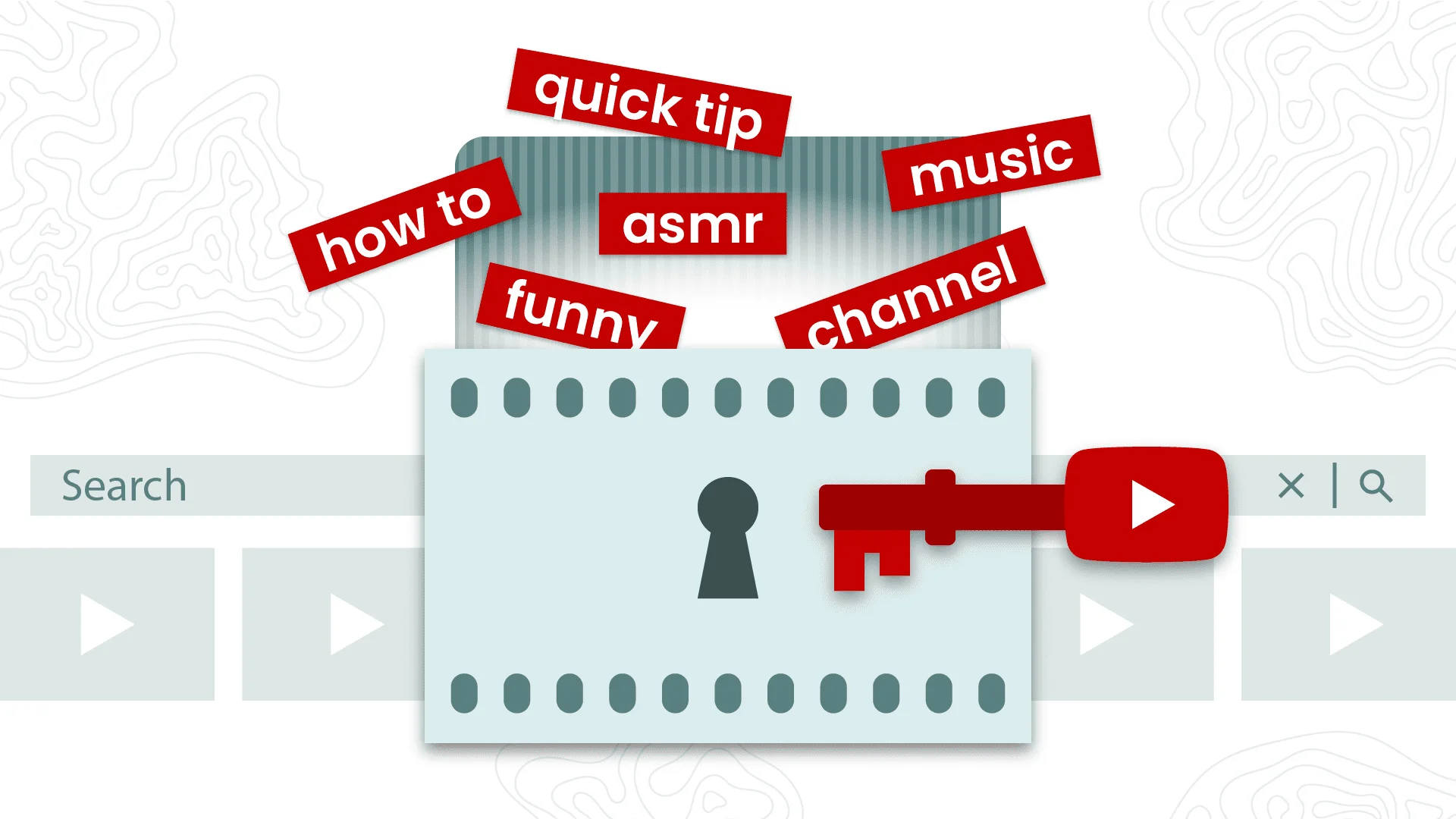Hey there! Keywords are the foundation of YouTube discoverability, acting as the bridge between your awesome content and your target audience.
Think of your YouTube channel as a ship lost at sea. Without a proper map (keyword research), you’re aimlessly drifting, hoping someone will stumble upon your island. But fear not, aspiring YouTuber! This guide is your treasure map to navigating the YouTube waters, helping you pinpoint the exact keywords that will attract your ideal viewers and send your channel soaring.
1. YouTube Keywords: Your Secret Weapon for World Domination
Why Keywords Matter: Are You Speaking the Same Language as Your Audience?
In the vast ocean of YouTube content, visibility is paramount. Keywords are the words and phrases that viewers type into the search bar when hunting for specific content. If your videos don’t contain these keywords, they’re essentially invisible to your target audience.
Imagine you’ve created a fantastic video about gourmet vegan cooking. But if you’re not using keywords like “vegan recipes,” “plant-based cuisine,” or “gourmet vegan meals,” you’re missing out on a massive pool of potential viewers who are actively searching for that exact content.
Understanding the Power of Keywords: It’s Not Just About Search Results!
Keywords don’t just affect your search ranking. They also influence:
- Recommended videos: YouTube’s algorithm uses keywords to understand your video’s topic and suggest it to viewers who have watched similar content.
- Audience targeting: Keywords help YouTube identify the right audience for your videos, ensuring they’re shown to people who are genuinely interested in your niche.
- Competitive analysis: Researching your competitors’ keywords can reveal untapped topics and opportunities to create content that stands out.
In short, keywords are the language of YouTube, and speaking it fluently is essential for attracting viewers, growing your channel, and achieving YouTube success.

2. Finding Your YouTube Niche: Stop Being a Jack-of-All-Trades and Become the Master of One!
Why Niche Matters: The Secret to Building a Loyal Fanbase
Trying to appeal to everyone is a recipe for disaster. The most successful YouTubers understand the power of focusing on a specific niche. A niche audience is the key to amassing views and followers. By honing in on a particular interest or hobby, content creators can cultivate a loyal following that is genuinely invested in their work. Implementing effective youtube audience growth strategies, such as targeted content creation and engagement with niche communities, can significantly enhance visibility and subscriber counts. This focused approach not only drives viewership but also fosters a deeper connection with the audience, leading to sustained success.
Think of it this way: would you rather have 100,000 subscribers who are mildly interested in your content, or 10,000 subscribers who are die-hard fans and hang on your every word? A niche audience is more engaged, more loyal, and more likely to share your content, leading to sustainable growth.
How to Find Your Niche: Uncover Your Passion and Turn It into a YouTube Empire!
Finding your niche involves a combination of self-discovery and market research. Here’s how to get started:
- Brainstorm your passions: What topics genuinely excite you? What are you knowledgeable about? What do you enjoy talking about?
- Identify your unique angle: What can you offer that’s different from existing content in your niche? Can you specialize in a sub-niche?
- Research keywords: Use tools like Google Keyword Planner to see what people are searching for within your potential niche.
- Analyze the competition: Who are the top YouTubers in your niche? What keywords are they using? What content is performing well?
- Experiment and refine: Don’t be afraid to try different topics and content styles to see what resonates with your audience.
For example, instead of a generic gaming channel, you could focus on speedrunning retro games. Instead of a general fitness channel, you could specialize in yoga for athletes. The more specific your niche, the easier it will be to attract a dedicated following.
3. YouTube SEO Essentials: Hack the Algorithm and Unleash Your Video’s True Potential!
Keyword Research: Dig Deep and Unearth the Keywords That Will Attract Millions!
Keyword research is the cornerstone of YouTube SEO. It involves identifying the best keywords to include in your video titles, descriptions, and tags. The right keywords will ensure that your videos are easily discoverable by users searching for similar content.
Here’s a step-by-step guide to effective keyword research:
- Brainstorm: Start by listing all the possible keywords related to your video’s topic.
- Use keyword research tools: Tools like Google Keyword Planner can help you find related keywords and analyze their search volume.
- Analyze the competition: See what keywords your competitors are using in their videos.
- Look for long-tail keywords: These are longer, more specific phrases that have less competition.
- Use keyword variations: Incorporate synonyms and related terms to broaden your reach.
Using Tags: Categorize Your Videos and Help YouTube Understand What They’re About!
Tags are another crucial element of YouTube SEO. They help YouTube’s algorithm understand your video’s content and suggest it to the right audience.
Here are some tips for using tags effectively:
- Use a mix of broad and specific tags: Include both general terms related to your niche and more specific keywords related to your video’s topic.
- Use all the available tag slots: Maximize your chances of being discovered by using all the tag slots that YouTube provides.
- Use relevant tags: Make sure your tags accurately reflect your video’s content.
Video Descriptions: Tell a Story and Entice Viewers to Click!
A well-written video description can significantly improve your video’s ranking on YouTube. It informs the viewer what to expect from your video.
Here’s how to write compelling video descriptions:
- Start with a strong hook: Grab the viewer’s attention in the first few sentences.
- Include relevant keywords: Incorporate your target keywords naturally throughout the description.
- Provide a summary of your video: Briefly explain what your video is about.
- Add a call to action: Encourage viewers to like, comment, subscribe, or visit your website.
Quality Content: The Ultimate Ranking Factor
Ultimately, the most important factor in YouTube SEO is creating high-quality content that resonates with your audience. YouTube’s algorithm prioritizes videos with more views, engagement, watch time, and longer retention rates.
Focus on creating videos that are engaging, informative, and valuable to your viewers. If you consistently deliver great content, your videos will naturally rank higher in search results and attract a larger audience.
4. Boosting Views with Keyword Research: Turn Your Channel into a View-Generating Machine!
The Power of Strategic Keyword Placement: Where to Put Your Keywords for Maximum Impact
Once you’ve identified your target keywords, it’s time to put them to work! Strategic keyword placement is essential for maximizing your video’s visibility.
Here’s where to include your keywords:
- Video title: This is the most important place to include your primary keyword.
- Video description: Incorporate your keywords naturally throughout the description.
- Video tags: Use a mix of broad and specific tags related to your video’s topic.
- Video script: Mention your keywords naturally in your video’s script or on-screen text.
Monitoring and Refining Your Keyword Strategy: Stay Ahead of the Curve and Dominate Your Niche!
Keyword research is not a one-time task. It’s an ongoing process that requires regular monitoring and refinement.
Trends and search behavior can change over time, so it’s important to revisit your list of keywords and update your content accordingly. Use YouTube Analytics to track your video’s performance and see which keywords are driving the most traffic. Experiment with new keywords and content formats to stay ahead of the curve and maintain your competitive edge.

5. Crafting Killer YouTube Titles: Write Headlines That Demand Attention and Get Clicks!
The Importance of a Great Title: Your First (and Maybe Only) Chance to Make an Impression
Your video title is the first thing viewers see when they come across your content. It’s your opportunity to grab their attention and convince them to click.
A killer YouTube title is attention-grabbing, informative, and optimized for search. It needs to accurately reflect your video’s content while also enticing viewers to watch.
Tips for Writing Irresistible Titles: Turn Casual Viewers into Raving Fans!
Here are some tips for crafting titles that get clicks:
- Use strong keywords: Incorporate your target keywords naturally in your title.
- Place your primary keyword at the beginning: This is the first thing viewers will see.
- Make it clear and concise: Use strong and active language.
- Add some creativity and humor: A catchy and funny title can make all the difference.
- Use numbers and lists: Titles with numbers and lists tend to perform well.
- Ask a question: Intrigue viewers by posing a question in your title.
- Create a sense of urgency: Use words like “now,” “today,” or “instant” to encourage immediate action.
For example, instead of “How to Make Vegan Pizza,” try “The Secret to PERFECT Vegan Pizza (You Won’t Believe How Easy!)”.

Conclusion
Keyword research is the cornerstone of YouTube success. By understanding the power of keywords, finding your niche, optimizing your videos for search, and crafting killer titles, you can unlock your channel’s true potential and attract a massive audience.
Don’t let your amazing content get lost in the sea of YouTube videos. Start implementing these strategies today and watch your views, subscribers, and engagement soar!
FAQs
What are some tools to use for keyword research on YouTube?
- There are several tools available to help with keyword research for YouTube, such as Google Keyword Planner, TubeBuddy, and vidIQ.
- Google Keyword Planner can be used to find search volume and competition data for keywords, while TubeBuddy and vidIQ offer YouTube-specific insights such as video ranking data and tag suggestions.
- You can also use YouTube’s autocomplete feature to see what phrases people are searching for related to your topic, and incorporate those keywords into your video content and metadata.
How do I search for keywords in a YouTube video?
- To search for keywords in a YouTube video, start by watching the video and taking note of its topic and main points.
- Use YouTube’s search bar to look for related videos and observe the default titles and descriptions that appear. This gives you an idea of what keywords and phrases are associated with this topic in the eyes of YouTube’s algorithm.
- You can also use third-party tools like VidIQ or TubeBuddy to analyze the keywords used in the video’s title, tags, and description. This helps you understand how the video is optimized for search and what keywords you can incorporate into your own video content.
What keywords are trending on YouTube?
- The keywords that are currently trending on YouTube are subject to change based on current global events, pop culture trends, and social media phenomena.
- However, some evergreen keywords that are always popular on YouTube include “how-to” videos, “unboxing” videos, “review” videos, and “tutorial” videos.
- You can also find currently popular keywords by looking at YouTube’s trending tab or using third-party tools like Google Trends, Ahrefs, or SEMrush to track search volume and trends over time.

